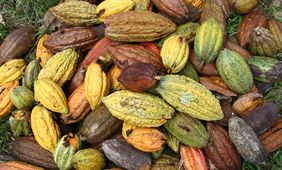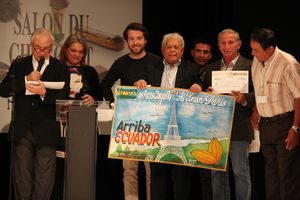
As the only event in the world celebrating the work of producers and the richness of expression of cocoa, a unique cocoa initiative is helping to further mutual awareness and reinforce collaborations between producers and chocolate makers.
Every two years, the Cocoa of Excellence Programme spearheaded by Bioversity International and Event International recognizes the quality, flavor and diversity of cocoas according to their origin, with the participation of countries that can directly present the fruits of their labors to chocolate makers and the press.
The Cocoa of Excellence Programme is the entry point for the International Cocoa Awards (ICA). It aims to increase awareness and promote education along the cocoa supply chain on the opportunity to produce high quality cocoa and preserve flavors resulting from genetic diversity, terroir and know-how of the farmers who prepare cocoa.
Cacao diversity is also vital for production, as it provides not only different flavors, but also resistance to pests and disease outbreaks, and resilience in changing climatic conditions. Providing opportunities and incentives for safeguarding diversity to farmers and national organizations ensures that a portfolio of options remain available for future needs.

Following the selection and evaluation of 166 cocoa samples submitted from 40 countries, the wait was finally over on Oct. 30, 2017, for the 50 entrants shortlisted for the 2017 Edition of the ICA. The 18 ICA winners were celebrated at the Salon du Chocolat in Paris, shining an international spotlight on the work of cocoa farmers and cocoa diversity around the world.
“It is the highest reward for the Salon du Chocolat to be with Bioversity International at the origin of this unique program that gathered so many great and indisputable international experts in the world of cacao. Our initial wish was to create a direct link between chocolate makers and producers for reciprocal enrichment, in the qualitative aspects of chocolate and cocoa with all the benefits they entail,” said Francois Jeantet, Creator of the Salon du Chocolat.
“Today our wishes are fulfilled. A big thank you to all the team and all those that participate with passion,” he added.
“The program facilitates communication and linkages between the producers of this wonderful crop that is cocoa that delights the bean buyers and chocolate makers. This communication needs to be standardized so that all the actors along the value chain understand each other, from the farmers to the chocolate makers,” explained Brigitte Laliberté, Expert on Cacao Genetic Resources at Bioversity International.
“We are coordinating an effort on the development of international standards for the assessment of cocoa quality and flavor, for which we convened a consultation at the Salon just this morning,” Laliberté continued. “The meeting led to some very exciting group decisions and innovations in this important area.”

After a physical quality evaluation, the beans were carefully processed into liquor and untempered chocolate for blind sensory evaluation by a panel of international experts who are part of the Cocoa of Excellence Technical Committee.
Following the evaluation, the best 50 samples were selected and processed into tempered and molded chocolate (following the same recipe of 66 percent cocoa) for sensory evaluation by a broader panel of 41 chocolate professionals.
“Never before has there been such an assemblage of superb cocoas as we have had expressed as chocolates in these 2017 Edition of Cocoa of Excellence. The flavor evaluation has been both daunting as well as exhilarating. There is more outstanding flavor and diversity from more countries than ever before. The Technical Committee and the additional jury have performed superbly,” said Ed Seguine, Cacao Cocoa and Chocolate Advisors/Guittard Chocolate.
“We continue to believe that the Cocoa of Excellence as well as the International Cocoa Awards will shine the spotlight of flavors, craftsmanship and diversity on these farmers and bring real, meaningful value to them for their beans,” he added.
The 18 International Cocoa Awards for 2017 are:
Africa & the Indian Ocean
- Ghana Simon Marfo – associated with Cocoa Abrabopa Association
- Madagascar Mava Sa – Ferme D’ottange
- Sierra Leone Sahr Bangura – associated with Kasiyatama
- Tanzania Kokoa Kamili Limited
Asia, Pacific & Australia
- Australia Australian Chocolate Pty Ltd
- Hawaii Jeanne Bennett and Bruce Clements – Nine Fine Mynahs Estates
- Hawaii University of Hawaii
- India Regal plantations
- Malaysia Teo Chun Hoon
Central America & Caribbean
- Dominica Stewart Paris – Paris Family – associated with North East Cocoa Growers Cooperative
- El Salvador José Eduardo Zacapa Campos
- Guatemala Asociación Waxaquib Tzikin
- Guatemala Mariel Ponce – Kacaou
- Martinique Kora Bernabe and Elizabeth Pierre-Louis – associated with Valcaco – Association des Producteurs de Cacao de Martinique
South America
- Bolivia Chocoleco
- Brazil Emir De Macedo Gomes Filho
- Ecuador Asociacion Quiroga
- Peru Cooperativa Agraria APPROCAP Ltda.
Adapted from the press release originally published by Bioversity International. For more information, contact Ines Drouault at the Cocoa of Excellence Programme: i.drouault(at)cgiar.org.
The Cocoa of Excellence (CoEx) Programme is the entry point for cocoa-producers to participate in the International Cocoa Awards (ICA). The programme is coordinated by Bioversity International, and jointly organized with Event International in partnership with the CGIAR Research Program on Forests, Trees and Agroforestry (FTA), Guittard Chocolate, Seguine Cacao, Cocoa and Chocolate, Barry Callebaut, Puratos and the International Cocoa Organization (ICCO) with sponsorship from the European Cocoa Association (ECA), the Association of Chocolate, Biscuit and Confectionery Industries of Europe (Caobisco), the Federation of Cocoa Commerce (FCC), Nestlé, the Lutheran World Relief (LWR), Mars UK, Valrhona and with in-kind contributions from the Cocoa Research Centre of the University of the West Indies (CRC/UWI), Valrhona, Weiss Chocolate and CocoaTown.
This work contributes to the CGIAR Research Program on Forests for Trees and Agroforestry, supported by CGIAR Fund Donors.











